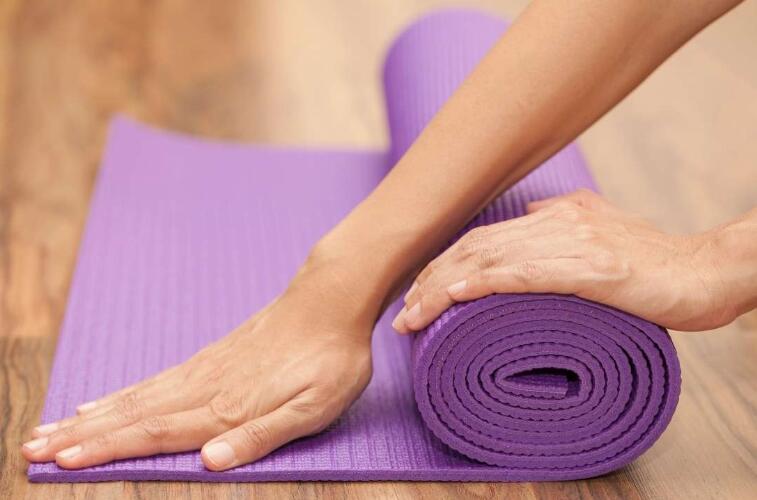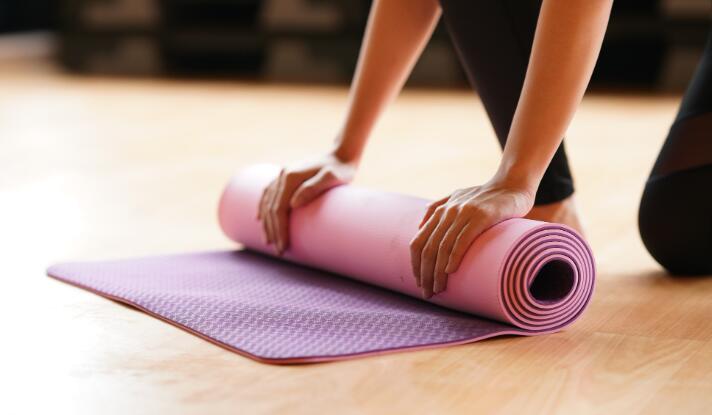When you’re shopping for a yoga mat, you might be wondering whether you should get a thick or thin mat.
The truth is, there’s no right answer – it all depends on your personal preferences and needs.
In this blog post, we’ll break down the pros and cons of each type of mat so you can make an informed decision about which one is right for you.
Why Choose Thick Yoga Mats?

Thick yoga mats are usually about 1/4-inch thick, though some can be as thick as 1 inch.
The main advantage of a thick mat is that it provides extra cushioning, which can be helpful if you have joint pain or sensitive knees.
Thick mats can also help prevent injuries by absorbing some of the impact when you land in certain poses.
If you are new to yoga, or if you tend to be a bit clumsy, a thick mat may be a good choice for you.
Another advantage of thick mats is that they provide insulation from the cold floor. This can be nice if you practice yoga in a chilly studio or if you.
On the downside, thick mats can be bulkier and more difficult to transport than thin mats. They also tend to be more expensive.
Why Choose Thin Yoga Mats?

As the name suggests, thin yoga mats are thinner than thick mats – usually around 1/16-inch thick.
The main advantage of a thin mat is that it’s lighter and easier to transport than a thick mat.
Additionally, thin mats can be more slippery than thick mats, which can make some poses more challenging (and dangerous) to execute.
Thin mats are also generally less expensive than thick mats.
On the downside, thin mats offer less cushioning than thick mats, so they might not be ideal if you have joint pain or sensitive knees.
How To Choose The Right Yoga Mat For You?
Now that we’ve gone over the pros and cons of thick and thin yoga mats, you might be wondering how to choose the right one for you.
Check the Thickness
One of the most important factors to consider when choosing a yoga mat is thickness.
A thicker mat will provide more cushioning, which can be beneficial for people with joint pain or for those who practice restorative yoga.
However, a thicker mat can also be more difficult to balance on, which may not be ideal for everyone.
If you’re unsure about which thickness is right for you, it’s always a good idea to try out a few different mats in person before making a purchase.
Consider the Material
The material of your yoga mat can also impact its performance. For example, mats made from PVC are often cheaper but can also be less durable and more slippery than other materials.
Mats made from natural rubber tend to be more expensive but are also more environmentally friendly and slip-resistant.
Ultimately, the material you choose is a matter of personal preference. Just make sure to do your research before buying so that you know what you’re getting.
Look for Design
Yoga mats come in all different shapes and sizes these days. Some are plain and simple while others are bright and patterned.
Again, this is a matter of personal preference. If you’re looking for something that stands out, there are plenty of options out there.
But if you prefer a more subdued look, that’s easy to find as well. It’s all up to you!
The best way to decide is to try out both types of mats and see which one feels more comfortable for you.
If you have joint pain or sensitive knees, a thick mat might be a better choice.
If you’re looking for a mat that is light and easy to transport, a thin mat might be the way to go.
Yoga Thickness For Beginners: What To Expect
Thick mats can provide more cushioning and support, while thin mats are lighter and more portable. Ultimately, the right mat for you depends on your personal preferences and needs.
If you are a beginner, you might be wondering how thick your yoga mat should be.
A good rule of thumb is to choose a mat that is at least ¼-inch thick. This will provide enough cushioning for most people.
If you have joint pain or sensitive knees, you may want to opt for a thicker mat, such as a ⅜-inch thick mat.
Remember, it’s always a good idea to try out a few different mats before making a purchase so that you can find the one that feels right for you.
No matter what thickness you choose, make sure to practice yoga with caution and listen to your body. If a pose feels too challenging or dangerous, be sure to modify it or skip it altogether.
Most importantly, have fun and enjoy your practice!
Conclusion
As you can see, there are pros and cons to both thick and thin yoga mats. It’s important to consider your own needs and preferences before making a purchase.
If you need extra cushioning or support for your joints, a thicker mat might be the better option. However, if you’re looking for a mat that’s easy to transport and relatively inexpensive, a thin mat might be the better choice.
Whichever type of mat you choose, make sure to do your research and buy from a reputable brand to ensure that you get a high-quality product that will last for years to come.
